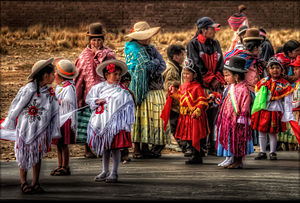- Culture of Bolivia
-
 Traditional folk dress during festival in Bolivia.
Traditional folk dress during festival in Bolivia.
Bolivia is a country in South America located at the Andes mountains. It has a Native American population which mixed Spanish cultural elements with their ancestors' traditions. The Spanish-speaking population mainly follows the Western customs.
The cultural development of what is present-day Bolivia is divided into three distinct periods: pre-Columbian, colonial, and republican. Important archaeological ruins, gold and silver ornaments, stone monuments, ceramics, and weavings remain from several important pre-Columbian cultures. Major ruins include Tiwanaku, Samaipata, Incallajta, and Iskanwaya. The country abounds in other sites that are difficult to reach and hardly explored by archaeologists.
The Spanish brought their own tradition of religious art which, in the hands of local indigenous and mestizo builders and artisans, developed into a rich and distinctive style of architecture, painting, and sculpture known as "Mestizo Baroque." The colonial period produced not only the paintings of Perez de Holguin, Flores, Bitti, and others but also the works of skilled, but unknown, stonecutters, woodcarvers, goldsmiths, and silversmiths. An important body of native baroque religious music of the colonial period was recovered in recent years and has been performed internationally to wide acclaim since 1994. Bolivian artists of stature in the 20th century include, among others, Guzman de Rojas, Arturo Borda, Maria Luisa Pacheco, Master William Vega, Alfredo Da Silva, and Marina Núñez del Prado.
Contents
Festivals
Pagan rites from the pre-Columbian era are still common during the religious festivals of the Natives. The clothing used during the festivals reminds the visitor of the pre-Columbian Indians and the 16th century Spaniards. The devil dances at the annual carnival of Oruro are amongst the great folkloric events of South America, as are the lesser known indigenous Anata Andina and the "carnival" at Tarabuco (Pujllay) or the Tinku-fertility rites held at Macha every 3rd of May.
Dances
 The Diablada, dance primival, typical and main of Carnival of Oruro a Masterpiece of the Oral and Intangible Heritage of Humanity since 2001 in Bolivia (Image: Fraternidad Artística y Cultural "La Diablada".
The Diablada, dance primival, typical and main of Carnival of Oruro a Masterpiece of the Oral and Intangible Heritage of Humanity since 2001 in Bolivia (Image: Fraternidad Artística y Cultural "La Diablada".
Many dances and songs contain elements from both the native and the European cultures. Caporales seems to be the most popular Bolivian dance of present times – in a few decades it developed into an enormous popular dance, not only in the Highlands, where it comes from, but also in the Lowlands and in the Bolivian communities outside the country. In the Highlands other traditional and still very popular dances are
- Morenada
- Kullawada
- Diablada
- Ch´utas
- Waka Waka-or they prefer Waca Waca
- Doctorcitos
- Suri Sicuri
- Tinku
- Pujllay
- Tobas
- Auqui Auqui
- Llamerada
- Cambitas
- Chacarera
- Afro-Bolivian Saya
In the Lowlands there are
- Macheteros
- Taquirari
- Chovena
Clothing
It is fashionable among Bolivian Andean women of indigenous descent to wear a skirt called a pollera. It was originally a Spanish peasant skirt that the colonial authorities forced the indigenous women to wear. Now it is also a symbol of pride in being indigenous and is also considered a status symbol.
Another fashion is the bowler hat, which was adopted from the British. The position of the hat can indicate a woman's marital status and aspirations.
Sport
See also: Bolivia national football team and Rugby union in BoliviaSoccer is the most popular Sport in Bolivia. The governing body of Soccer in Bolivia is the Federación Boliviana de Fútbol (FBF), which controls the national teams. The FBF organises the Men's, Women's, and Futsal national teams.
The Bolivian national football team is currently ranked 65th in the world, with their best FIFA ranking being 18th in the world. The national team has competed at 3 FIFA World Cups, 23 Copa América Championships, and 1 Confederations Cup.
Appearances 3 (First in 1930)
Best result Round 1, 1930, 1950, and 1994
Appearances 23 (First in 1926)
Best result Winners, 1963
Confederations Cup
Appearances 1 (First in 1999)
Best result Round 1, 1999
Rugby
Rugby union in Bolivia is a minor but growing Sport.
List of Bolivian Sports peopleFamous Bolivian Cyclists:
Famous Bolivian Chess players:- Paul Baender
Famous Bolivian Runners:
- Juan Camacho (athlete)
Famous Bolivian Skiers:- Scott Sánchez
Famous Bolivian Tennis players:
Famous Bolivian Swimmers:- Alberto Conrad
- Katerine Moreno
- Andrew Rutherfurd
- Karen Torrez
Famous Bolivian Shooters:- Fernando Inchauste
More information on Bolivian Football:See also: Bolivia women's national football team and Bolivia national futsal teamMusic
Main article: Music of BoliviaBolivia's regional folk music is distinctive and varied. In the Andean regions music is played during the festivals and the dances. Some tunes contain strong Spanish influences.
The most common musical instruments are:
- sicu (also "sicus")
- * tarka or tharqa
- pinkillo
- skin drums
- * copper bells
- wood.
- flute
- Zampoña
- Matraca
- Mandolina
Books
See also
- Latin American culture
- Hispanic culture
External links
Latin American culture North America 
Central America Caribbean - Antigua and Barbuda
- Bahamas
- Barbados
- Cuba
- Dominica
- Dominican Republic
- Grenada
- Haiti
- Jamaica
- Puerto Rico1
- St. Kitts and Nevis
- St. Lucia
- St. Vincent and the Grenadines
- Trinidad and Tobago
South America - Dependencies not included.
- 1 Defined as a semi-autonomous territory.
 Bolivia topics
Bolivia topicsHistory Geography Departments · Provinces · Cities · Lakes · Mountains · Volcanoes · Rivers · Climate · Environmental issues · Extreme pointsPolitics President · Government · Political parties · Elections · Constitution · Foreign relations · Military · Law enforcement · Human rights (LGBT rights)Economy Tourism · Boliviano · Communications · Transport · Energy · Sanitation · Health · International rankingsDemographics Culture Other topics Index • Portal Categories:- Bolivian culture
Wikimedia Foundation. 2010.
